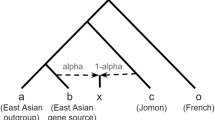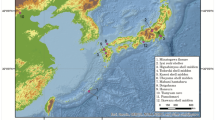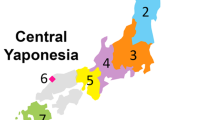Abstract
We analyzed the mitochondrial DNA extracted from 14 human skeletal remains from the Doigahama site in Japan to clarify the genetic structure of the Doigahama Yayoi population and the relationship between burial style and kinship among individuals. The sequence types obtained in this study were compared with those of the modern Japanese, northern Kyushu Yayoi and ancient Chinese populations. We found that the northern Kyushu Yayoi populations belonged to the groups that include most of the modern Japanese population. In contrast, most of the Doigahama Yayoi population belonged to the group that includes a small number of the modern Japanese population. These results suggest that the Doigahama Yayoi population might have contributed less to the formation of the modern Japanese population than the northern Kyushu Yayoi populations. Moreover, when we examined the kinship between individuals in the Doigahama site, we found that the vicinal burial of adult skeletons indicated a maternal kinship, although that of juvenile skeletons did not. The vicinal burial style might have been influenced by many factors, such as paternal lineages, periods and geographical regions, as well as maternal lineages. In addition, skeletons considered to be those of shamans or leaders had the same sequence types. Their crucial social roles may have been inherited through maternal lineage.
Similar content being viewed by others
Log in or create a free account to read this content
Gain free access to this article, as well as selected content from this journal and more on nature.com
or
References
Hanihara, K. Dual structure model for the population history of the Japanese. Jpn Rev. 2, 1–33 (1991).
Kanaseki, T. The question of the Yayoi people. in Symposium on Japanese Archaeology Vol. 4 (ed Sugihara, S.) 238–252 (Kawade Shobo, Tokyo, 1956) (in Japanese).
Dodo, Y., Ishida, H. & Saitou, N. Population history of Japan: a cranial nonmetric approach. in The Evolution and Dispersal of Modern Humans in Asia (eds Akazawa, T., Aoki, K. & Kimura, T.) 479–492 (Hokusen-sha, Tokyo, 1992).
Yamaguchi, B. Skeletal morphology of the Jomon people in Japanese as a Member of the Asian and Pacific Populations (ed Hanihara, K.) 53–63 (International Research Center for Japanese Studies. Nan’un-do, Kyoto, 1992) (in Japanese).
Turner, C. G. II. Late Pleistocene and Holocene population history of East Asia based on dental variation. Am. J. Phys. Anthropol. 73, 305–321 (1987).
Turner, C. G. II. Major features of sundadonty and sinodonty, including suggestions about East Asian microevolution, population history, and late Pleistocene relationships with Australian Aboriginals. Am. J. Phys. Anthropol. 82, 295–317 (1990).
Brace, C. L., Brace, M. L. & Leonard, W. L. Reflections on the face of Japan: a multivariate craniofacial and odontometric perspective. Am. J. Phys. Anthropol. 78, 93–113 (1989).
Brace, C. L. & Hunt, K. D. A nonracial craniofacial perspective on human variation: A(ustralia) to Z(uni). Am. J. Phys. Anthropol. 82, 341–360 (1990).
Dodo, Y. & Ishida, H. Population history of Japan as viewed from cranial nonmetric variation. J. Anthrop. Soc. Nippon. 98, 269–287 (1990).
Kozintsev, A. Ainu, Japanese, their ancestors and neighbours: cranioscopic data. J. Anthrop. Soc. Nippon. 98, 247–267 (1990).
Kozintsev, A. Prehistoric and recent populations of Japan: multivariate analysis of cranioscopic data. Arctic Anthropol. 29, 104–111 (1992).
Lahr, M. M. The Evolution of Modern Human Diversity: A Study of Cranial Variation (Cambridge University Press, Cambridge, 1996).
Ossenberg, N. S., Dodo, Y., Maeda, T. & Kawakubo, Y. Ethnogenesis and craniofacial change in Japan from the perspective of nonmetric traits. Anthropol. Sci. 114, 99–115 (2006).
Matsushita, T. Sharekoube ga kataru. Nihonnjin no ruutsu to mirai. [Talking by crania. Roots and future of the Japanese.] (Nagasaki Shinbunsha, Nagasaki, 2001) (in Japanese).
Aikens, C. M. & Higuchi, T. Prehistory of Japan (Academic Press, New York, 1982).
Ushijima, Y. The human skeletal remains from the Mitsu site, Saga prefecture, a site associated with the “Yayoishiki” period of prehistoric Japan. Jinruigaku Kenkyu 1, 273–303 (1954) (in Japanese).
Zaitsu, H. On the limb bones of certain Yayoi-period ancients, excavated at the Doigahama site, Yamaguchi prefecture. Jinruigaku Kenkyu 3, 320–349 (1956) (in Japanese).
Kanaseki, T., Nagai, M. & Sano, H. Craniologic studies of the Yayoi-period ancients, excavated at the Doigahama site, Yamaguchi prefecture. Jinruigaku Kenkyu 7 (Suppl.), 1–36 (1960) (in Japanese with English summary).
Kanaseki, T. The question of the Yayoi people. in Symposium on Japanese Archaeology Vol. 3 (ed Wajima, S.) 460–471 (Kawade Shobo, Tokyo, 1966) (In Japanese).
Matsushita, T., Wakebe, T., Sakuma, M., Nakatani, S., Naito, Y. & Ishida, H. An anthropological study on the human skeletons of Yayoi period excavated from Takuta-Nishibun Shell Mound, Saga prefecture. Kaibogaku Zasshi 59, 411 (1984) (in Japanese).
Nakahashi, T. & Nagai, M. Morphological characteristics of the Yayoi people. in Study of Yayoi Culture Vol. 1 (eds Nagai, M., Kanaseki, H., Nasu, T. & Sahara, M.) 23–51 (Yuzankaku shuppan, Tokyo, 1989) (in Japanese).
Saiki, R. K., Scharf, S., Faloona, F., Mullis, K. B., Hors, G. T., Erlich, H. A. et al. Enzymatic amplification of beta-globin genomic sequences and restriction site analysis for diagnosis of sickle cell anemia. Science 230, 1350–1354 (1985).
Saiki, R. K., Gelfand, D. H., Stoffel, S., Scharf, S. J., Higuchi, R., Horn, G. T. et al. Primer-directed enzymatic amplification of DNA with a thermostable DNA polymerase. Science 239, 487–491 (1988).
Pääbo, S., Gifford, J. A. & Wilson, A. C. Mitochondrial DNA sequences from a 7000-year old brain. Nucleic Acid. Res. 16, 9775–9787 (1988).
Stone, A. C. & Stoneking, M. Ancient DNA from a pre-Columbian Amerindian population. Am. J. Phys. Anthropol. 92, 463–471 (1993).
Stone, A. C. & Stoneking, M. Analysis of ancient DNA from a prehistoric Amerindian cemetery. Philos. Trans. R. Soc. Lond. 354, 153–159 (1999).
Handt, O., Hoss, M., Krings, M. & Pääbo, S. Ancient DNA: methodological challenges. Experientia 50, 524–529 (1994).
Krings, M., Stone, A. C., Schmitz, R. W., Krainitzki, H., Stoneking, M. & Pääbo, S. Neandertal DNA sequences and the origin of modern humans. Cell 90, 19–30 (1997).
Krings, M., Capelli, C., Tschentscher, F., Geisert, H., Meyer, S., von Haeseler, A. et al. A view of Neandertal genetic diversity. Nat. Genet. 26, 144–146 (2000).
Keyser, C., Crubezy, E. & Ludes, B. Nuclear and mitochondrial DNA analysis of a 2000-years-old necropolis in the Egyin Gol valley of Mongolia. Am. J. Hum. Genet. 73, 247–260 (2003).
Ricaut, F., Keyser, C., Cammaert, L., Crubezy, E. & Ludes, B. Genetic analysis and ethnic affinities from two Scytho-Siberian skeletons. Am. J. Phys. Anthropol. 123, 351–360 (2004).
Ricaut, F., Kolodesnikov, S., Keyser, C., Alekseev, A., Crubezy, E. & Ludes, B. Molecular genetic analysis of 400-year-old human remains found in two Yakut burial sites. Am. J. Phys. Anthropol. 129, 55–63 (2006).
Clisson, I., Keyser, C., Francfort, H. P., Crubezy, E., Samashev, Z. & Ludes, B. Genetic analysis of human remains from a double inhumation in frozen kurgan in Kazakhstan (Berel site, Early 3rd Century BC). Int. J. Legal Med. 116, 304–308 (2002).
Horai, S., Hayasaka, K., Murayama, K., Wate, N., Koike, H. & Nakai, N. (1989) DNA amplification from ancient human skeletal specimens and their sequence analysis. Proc. Jpn Acad. 65 (Ser. B), 229–233 (1989).
Kurosaki, K., Matsushita, T. & Ueda, S. Individual DNA identification from ancient human remains. Am. J. Hum. Genet. 53, 638–643 (1993).
Shinoda, K. & Kunisada, T. Analysis of ancient Japanese society through mitochondrial DNA sequencing. Int. J. Osteoarchaeol. 4, 294–297 (1994).
Oota, H., Saitou, N., Matsushita, T. & Ueda, S. A genetic study of 2000-year-old human remains from Japan using mitochondrial DNA sequences. Am. J. Phys. Anthropol. 98, 133–145 (1995).
Shinoda, K., Matsumura, H. & Nishimoto, T. Genetical and morphological analysis on kinship of Nakazuma Jomon people using mitochondrial DNA and tooth crown measurement. Zoo-archaeology 11, 1–21 (1998) (in Japanese with English summary).
Shinoda, K. & Kanai, S. Intracemetery genetic analysis at the Nakazuma Jomon site in Japan by mitochondrial DNA sequencing. Anthropol. Sci. 107, 129–140 (1999).
Adachi, N., Dodo, Y., Ohshima, N., Doi, N., Yoneda, M. & Matsumura, H. Morphologic and genetic evidence for kinship of juvenile skeletal specimens from a 2000 years-old double burial of Usu-Moshiri site, Hokkaido, Japan. Anthropol. Sci. 111, 347–363 (2003).
Adachi, N., Umetsu, K., Takigawa, W. & Sakaue, K. Phylogenetic analysis of the human ancient mitochondrial DNA. J. Archaeol. Sci. 31, 1339–1348 (2004).
Adachi, N., Suzuki, T., Sakaue, K., Takigawa, W., Ohshima, N. & Dodo, Y. Kinship analysis of the Jomon skeletons unearthed from a double burial at the Usu-Moshiri site, Hokkaido, Japan. Anthropol. Sci. 114, 29–34 (2006).
Sato, T., Amano, T., Ono, H., Ishida, H., Kodera, H., Matsumura, H. et al. Origins and genetic features of the okhotsk people, revealed by ancient mitochondrial DNA analysis. J. Hum. Genet. 52, 618–627 (2007).
Hanihara, K., Yamaguchi, A. & Mizoguchi, Y. Statistical analysis on kinship among skeletal remains excavated from a Neolithic site at Uwasato, Iwate Prefecture. J. Anthrop. Soc. Nippon 91, 49–68 (1983) (in Japanese with English summary).
Doi, N., Tanaka, Y. & Funakoshi, K. An approach on kinship among skeletal remains from Uenoharu tunnel-tombs, Oita Prefecture. J. Anthrop. Soc. Nippon 93, 206 (1985) (in Japanese with English title).
Matsumura, H. & Nishimoto, T. Statistical analysis on kinship of Nakazuma Jomon people using tooth crown measurements. Zoo-archaeology 6, 1–17 (1996) (in Japanese with English summary).
Alt, K. W., Pichler, S., Vach, W., Klima, B., Vlcek, E. & Sedlmeier, J. Twenty-five thousand-year-old triple burial from Dolni Vestonice: an ice age family? Am. J. Phys. Anthropol. 102, 123–131 (1997).
Formicola, V. & Buzhilova, A. P. Double child burial from Sunghir (Russia): pathology and inferences for upper Paleolithic funerary practices. Am. J. Phys. Anthropol. 124, 189–198 (2004).
Pääbo, S., Irwin, D. M. & Wilson, A. C. DNA damage promotes jumping between templates during enzymatic amplification. J. Biol. Chem. 265, 4718–4721 (1990).
Pääbo, S., Poinar, H., Serre, D., Jaenicke-Despres, V., Heber, J., Rohland, N. et al. Genetic analysis from ancient DNA. Annu. Rev. Genet. 38, 645–679 (2004).
Bouwman, A. S., Chilvers, E. R., Brown, K. A. & Brown, T. A. Brief communication: identification of the authentic ancient DNA sequence in a human bone contaminated with modern DNA. Am. J. Phys. Anthropol. 131, 428–431 (2006).
Shinoda, K. Ancient DNA analysis of skeletal samples recovered from the Kuma-Nishioda Yayoi site. Bull. Natl Sci. Mus. Ser. D 30, 1–8 (2004).
Gilbert, M. T., Willerslev, E., Hansen, A. J., Barnes, I., Rudbeck, L., Lynnerup, N. et al. Distribution patterns of postmortem damage in human mitochondrial DNA. Am. J. Hum. Genet. 72, 32–47 (2003).
Gilbert, M. T., Hansen, A. J., Willerslev, E., Rudbeck, L., Barnes, I., Lynnerup, N. et al. Characterization of genetic miscoding lesions caused by postmortem damage. Am. J. Hum. Genet. 72, 48–61 (2003).
Hofreiter, M., Jaenicke, V., Serre, D., von Haeseler, A. & Pääbo, S. DNA sequences from multiple amplifications reveal artifacts induced by cytosine deamination in ancient DNA. Nucleic Acid. Res. 29, 4793–4799 (2001).
Andrews, R. M., Kubacka, I., Chinnery, P. F., Lightowlers, R. N., Turnbull, D. M. & Howell, N. Reanalysis and revision of the Cambridge reference sequence for human mitochondrial DNA. Nat. Genet. 23, 147 (1999).
Tanaka, M., Cabrera, V. M., Gonzalez, A. M., Larruga, J. M., Takeyasu, T., Fuku, N. et al. Mitochondrial genome variation in Eastern Asia and peopling of Japan. Genome Res. 14, 1832–1850 (2004).
Tajima, A., Hayami, M., Tokunaga, K., Juji, T., Matsuo, M., Marzuki, S. et al. Genetic origins of the Ainu inferred from combined DNA analyses of maternal and paternal lineages. J. Hum. Genet. 49, 187–193 (2004).
Irwin, J. A., Saunier, J. L., Strouss, K. A., Diegoli, T. M., Sturk, K. M., O’Callaghan, J. E. et al. Mitochondrial control region sequences from a Vietnamese population sample. Int. J. Legal Med. 122, 257–259 (2008).
Yao, Y. G., Lu, X. M., Luo, H. R., Li, W. H. & Zhang, Y. P. Gene admixture in the silk road region of China: evidence from mtDNA and melanocortin 1 receptor polymorphism. Genes Genet. Syst. 75, 173–178 (2000).
Yao, Y. G., Kong, Q. P., Bandelt, H. J., Kivisild, T. & Zhang, Y. P. Phylogeographic differentiation of mitochondrial DNA in Han Chinese. Am. J. Hum. Genet. 70, 635–651 (2002).
Yao, Y. G., Nie, L., Harpending, H., Fu, Y. X., Yuan, Z. G. & Zhang, Y. P. Genetic relationship of Chinese ethnic populations revealed by mtDNA sequence diversity. Am. J. Phys. Anthropol. 118, 63–76 (2002).
Yao, Y. G., Kong, Q. P., Man, X. Y., Bandelt, H. J. & Zhang, Y. P. Reconstructing the evolutionary history of China: a caveat about inferences drawn from ancient DNA. Mol. Biol. Evol. 20, 214–219 (2003).
Yao, Y. G., Kong, Q. P., Wang, C. Y., Zhu, C. L. & Zhang, Y. P. Different matrilineal contributions to genetic structure of ethnic groups in the silk road region in China. Mol. Biol. Evol. 21, 2265–2280 (2004).
Li, H., Cai, X., Winograd-Cort, E. R., Wen, B., Cheng, X., Qin, Z. et al. Mitochondrial DNA diversity and population differentiation in southern East Asia. Am. J. Phys. Anthropol. 134, 481–488 (2007).
Horai, S., Murayama, K., Hayasaka, K., Matsubayashi, S., Hattori, Y., Fucharoen, G. et al. mtDNA polymorphism in East Asian populations, with special rerferece to the peopling of Japan. Am. J. Hum. Genet. 59, 579–590 (1996).
Kong, Q. P., Yao, Y. G., Liu, M., Shen, S. P., Chen, C., Zhu, C. L. et al. Mitochondrial DNA sequence polymorphisms of five ethnic populations from northern China. Hum. Genet. 113, 391–405 (2003).
Kong, Q.-P., Yao, Y.-G., Sun, C., Bandelt, H.-J., Zhu, C.-L. & Zhang, Y.-P. Phylogeny of east Asian mitochondrial DNA lineages inferred from complete sequences. Am. J. Hum. Genet. 73, 671–676 (2003).
Kong, Q. P., Bandelt, H. J., Sun, C., Yao, Y. G., Salas, A., Achilli, A. et al. Updating the East Asian mtDNA phylogeny: a prerequisite for the identification of pathogenic mutations. Hum. Mol. Genet. 15, 2076–2086 (2006).
Yao, Y. G. & Zhang, Y. P. Phylogeographic analysis of mtDNA variation in four ethnic populations from Yunnan Province: new data and a reappraisal. J. Hum. Genet. 47, 311–318 (2002).
Hill, C., Soares, P., Mormina, M., Macaulay, V., Clarke, D., Blumbach, P. B. et al. A mitochondrial stratigraphy for Island Southeast Asia. Am. J. Hum. Genet. 80, 29–43 (2007).
Tajima, A., Sun, C. S., Pan, I. H., Ishida, T., Saitou, N. & Horai, S. Mitochondrial DNA polymorphisms in nine aboriginal groups of Taiwan: implications for the population history of aboriginal Taiwanese. Hum. Genet. 113, 24–33 (2003).
Aquadro, C. & Greenberg, B. Human mitochondrial DNA variation and evolution: analysis of nucleotide sequences from seven individuals. Genetics 103, 287–312 (1983).
Brown, W., George, M. & Wilson, A. Rapid evolution of animal mitochondrial DNA. Proc. Natl Acad. Sci. USA 76, 1967–1971 (1979).
Oota, H., Saitou, N., Matsushita, T. & Ueda, S. Molecular genetic analysis of remains of a 2000-year-old human population in China—and its relevance for the origin of the modern Japanese population. Am. J. Hum. Genet. 64, 250–258 (1999).
Oota, H., Saitou, N. & Ueda, S. A large-scale analysis of human mitochondrial DNA sequences with special reference to the population history of east Eurasian. Anthropol. Sci. 110, 293–312 (2002).
Wang, L., Oota, H., Saitou, N., Jin, F., Matsushita, T. & Ueda, S. Genetic structure of a 2500-year-old human population in China and its spatiotemporal changes. Mol. Biol. Evol. 17, 1396–1400 (2000).
Arifuku, H. Tracking summary. In Report of the 14th Excavation Research at the Doigahama Site (eds Matsushita, T. & Arifuku, F.) 8–17 (Educational committee of Hohokucho, Yamaguchi, Yamaguchi, 1996) (in Japanese).
Harunari, H. The meaning of ritual tooth ablation. Q, Archaeol. Stud. 20, 25–48 (1973) (in Japanese).
Nakahashi, T. Ritual tooth-ablation in Doigahama Yayoi people. J. Anthrop. Soc. Nippon 98, 483–507 (1990) (in Japanese with English summary).
Matsushita, T. Ancient human skeletons from 14th excavation research at the Doigahama site, Yamaguchi prefecture. in Report of the 14th Excavation Research at the Doigahama Site (eds Matsushita, T. & Arifuku, F.) 24–50 (Educational committee of Hohokucho, Yamaguchi, Yamaguchi, 1996) (in Japanese).
Doi, N. Osteometrical study of genetic and environmental influence on the shape of the human skeleton: I. Intra-familiar resemblances in the skeletal morphology of the Kanaseki-family and other familial series. J. Anthrop. Soc. Nippon 99, 437–462 (1991) (in Japanese with English summary).
Matsushita, T., Matsushita, R., Isobe, M., Nakano, E. & Nakano, N. Ancient human skeletons from 19th excavation research at the Doigahama site, Yamaguchi prefecture. in Report of the 19th Excavation Research at the Doigahama site (eds Matsushita, T., & Furushou, H.) 18–46 (Doigahama site anthropological museum, Yamaguchi, 2002) (in Japanese).
Furushou, H. Relics and remains in Report of the 19th Excavation Research at the Doigahama Site (eds Matsushita, T. & Furushou, H.) 7–17 (Doigahama Site Anthropological Museum, Yamaguchi, 2002) (In Japanese).
Yamada, Y. Issue of the Doigahama site. in Report of the 17th Excavation Research at the Doigahama Site (ed Yamada, Y.) 28–33 (Educational committee of Hohokucho and Doigahama site anthropological museum, Yamaguchi, 1999) (in Japanese).
Tsuboi, K. & Kanaseki, H. Value of the Doigahama site. in Report of Conservation Management Plan in the Doigahama site 1–22 (Educational Committee of Hohokucho, Yamaguchi, 1978) (in Japanese).
Matsushita, T. Ancient human skeletons from 13th excavation research at the Doigahama site, Yamaguchi prefecture. in Report of the 13th Excavation Research at the Doigahama Site (ed Okayasu, Y.) 19–33 (Educational Committee of Hohokucho, Yamaguchi, 1995) (in Japanese).
Matsushita, T. Ancient human skeletons from 16th excavation research at the Doigahama site, Yamaguchi prefecture. in Report of the 16th Excavation Research at the Doigahama Site (ed Yamada, Y.) suppl. 24–50 (Doigahama Site Anthropological Museum, Yamaguchi, 1998) (in Japanese).
Acknowledgements
We express sincere gratitude to Dr K Umetsu, Yamagata University, for helpful suggestions regarding the mtDNA analyses. We also thank the members of the Forensic Science Laboratory, Nagasaki Prefectural Police Headquarters and the members of the Doigahama Site Anthropological Museum for their help in conducting this research. We also thank all those who kindly provided us with fingernail and hair follicle samples for the DNA contamination analysis.
Author information
Authors and Affiliations
Corresponding author
Rights and permissions
About this article
Cite this article
Igawa, K., Manabe, Y., Oyamada, J. et al. Mitochondrial DNA analysis of Yayoi period human skeletal remains from the Doigahama site. J Hum Genet 54, 581–588 (2009). https://doi.org/10.1038/jhg.2009.81
Received:
Revised:
Accepted:
Published:
Issue date:
DOI: https://doi.org/10.1038/jhg.2009.81



